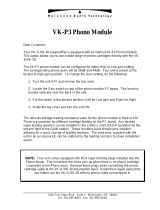
4826 Sterling Drive, Boulder, CO 80301 Owner’s Guide
Rev B
Owner’s Guide
©2013 PS Audio Inc. All rights reserved.
®
Owner’s Reference NuWave Phono Converter
cartridge, the typical load would be 100 Ohms. Move switches 9 and 10 to the up position keeping
all the other switches (8-1) in the down position. You can also see some other groupings on the back
panel. For example, 60 Ohms can be achieved by placing switches 7,8,9,10 in the up position while
all others are down. 600 Ohms can be achieved with switches 3,4,5,6 in the up position while all
others down.
If you are only using the NPC for phono, you can skip this next bit and go directly to connecting its
outputs up. If you are also - or only - connecting a flat analog source to the NPC, such as a tape deck,
tuner, iPod, VCR analog outputs, etc., then this next part is for you.
If you are planning on using the NPC for analog sources other than a turntable, you will connect the
source to the left and right inputs labeled Line In. Line In is a single ended RCA input that can accept
the output from just about any analog source such as a tuner or tape deck. The input impedance is
a fairly easy load of 47k Ohm which should accommodate a tube, solid state or transformer coupled
output with ease. Again, make sure these inputs are connected to the correct channels for proper left
and right reproduction. Maximum input voltage is 3v
rms
and the bandwidth extends to 80kHz.
It is fine to have both the Phono Inputs as well as the analog inputs connected at the same time.
Selection of the two inputs is chosen from the front panel display.
There are two analog outputs on the NPC: balanced XLR analog output and unbalanced, RCA analog
output. You may connect either or both of these outputs to any preamplifier or analog mixing console
you wish. They may be used separately or at the same time if needed. Only the phono input will
come through the analog outputs.
There are 4 digital connectors on the rear panel of the NPC. From left to right as you face the rear of
the unit those connectors are labeled: Firmware, S/PDIF, I
2
S, USB.
The firmware connector is used only for firmware updates SHOULD there be any released from us.
To use this input you will insert a USB memory stick containing the firmware update, power cycle the
unit and it will take care of the rest. With the NPC rear panel power switch in the off position, insert
the USB firmware memory upgrade if you are ever instructed to do so (normally you will not need to
do this). Once inserted, turn the rear panel power switch to the ON position and refer to the front
panel display. Do not remove power until the front panel blue logo light stops flashing or the unit
reboots. The new firmware will be installed. Once installed, turn the rear panel power switch to the
OFF position, remove the USB memory stick, and return power to the unit.
S/PDIF is a digital output that can be used to feed a DAC (Digital to Analog Converter), digital mixing
console or computer sound card. This output uses the S/PDIF (Sony Phillips Digital Interface) standard
and will send either PCM and DSD to any compatible receiver. PCM can be sent from 44.1kHz/16 bit
through 192kHz/24 bit and all standard variations between these two extremes. DSD is sent using the
DoP protocol (DSD over PCM) and produces single or double DSD rate. The DoP protocol maintains
the original DSD data without corruption to the original source. To do this, it breaks up the DSD
stream into smaller individual packets that resemble PCM. Your DSD capable DAC will recombine
these packets back together to give you perfect DSD. If you are using this output be sure and use the
highest quality connecting cable appropriate for data transmission.
Digital Outputs
Firmware Upgrades
S/PDIF Output
Analog Outputs
Other Analog
Sources
4























